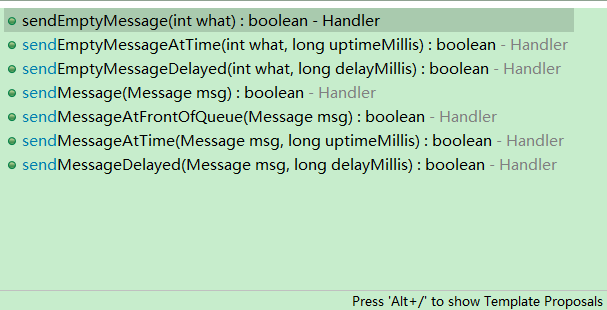1. 介绍
在之前的篇幅中介绍了Handler任务模型中Message类和Looper类的源码分析,本篇将分析Handler类和Message类。
2. 源码分析
- Handler类
之前 Handler任务模型之Looper类分析得到博乐评论说应该从使用开始到源码分析,这样可以使条理更加清晰,所以咱们先看下Handler的使用
private Handler handler = new Handler() {
public void handleMessage(android.os.Message msg) {
//.................
};
};Message msg = Message.obtain();
msg.what = 0;
handler.sendMessage(msg);我们一般是这样使用Handler的,首先谈下Handler的构造,Handler类本身提供了四种构造方法
public Handler() {
mLooper = Looper.myLooper();
if (mLooper == null) {
throw new RuntimeException(
"Can't create handler inside thread that has not called Looper.prepare()");
}
mQueue = mLooper.mQueue;
mCallback = null;
}public Handler(Callback callback) {
mLooper = Looper.myLooper();
if (mLooper == null) {
throw new RuntimeException(
"Can't create handler inside thread that has not called Looper.prepare()");
}
mQueue = mLooper.mQueue;
mCallback = callback;
} public Handler(Looper looper) {
mLooper = looper;
mQueue = looper.mQueue;
mCallback = null;
} public Handler(Looper looper, Callback callback) {
mLooper = looper;
mQueue = looper.mQueue;
mCallback = callback;
}四种构造函数主要是为了三个变量赋值,第一个是mLooper,第二个是mQueue,第三个是mCallBack。
其中Looper是一个循环体,MessageQueue保持着Message消息链的引用,mCallBack提供一个回调方法在handlerMessage之前执行。
Handler类本身提供了很多的发送消息的方法和post的方法

这些方法内部最后都是同一调用sendMessageAtTime这个方法
public boolean sendMessageAtTime(Message msg, long uptimeMillis)
{
boolean sent = false;
MessageQueue queue = mQueue;
if (queue != null) {
msg.target = this;
sent = queue.enqueueMessage(msg, uptimeMillis);
}
else {
RuntimeException e = new RuntimeException(
this + " sendMessageAtTime() called with no mQueue");
Log.w("Looper", e.getMessage(), e);
}
return sent;
}第6行:将Message的target赋值为this,可以看出一个Message对应一个Handker,谁发送的消息还要交给谁处理,只是在主线程绕一圈而已
第7行:将msg投递到消息链中
- MessageQueue源码分析
handler的sendMessageAtTime方法内部调用MessageQueue的enqueueMessage投递任务
final boolean enqueueMessage(Message msg, long when) {
if (msg.when != 0) {
throw new AndroidRuntimeException(msg
+ " This message is already in use.");
}
if (msg.target == null && !mQuitAllowed) {
throw new RuntimeException("Main thread not allowed to quit");
}
final boolean needWake;
synchronized (this) {
if (mQuiting) {
RuntimeException e = new RuntimeException(
msg.target + " sending message to a Handler on a dead thread");
Log.w("MessageQueue", e.getMessage(), e);
return false;
} else if (msg.target == null) {
mQuiting = true;
}
msg.when = when;
//Log.d("MessageQueue", "Enqueing: " + msg);
Message p = mMessages;
if (p == null || when == 0 || when < p.when) {
msg.next = p;
mMessages = msg;
needWake = mBlocked; // new head, might need to wake up
} else {
Message prev = null;
while (p != null && p.when <= when) {
prev = p;
p = p.next;
}
msg.next = prev.next;
prev.next = msg;
needWake = false; // still waiting on head, no need to wake up
}
}
if (needWake) {
nativeWake(mPtr);
}
return true;
}第2-5行:通过msg.when对消息进行校验,新消息默认是没有when赋值的,如果此时msg.when != 0说明已经执行该Message正在被使用。不能再次被添加到链表中去
第6-8行:在之前的篇幅中我们介绍过当msg.target为空作为Looper消息循环结束的一个标志位,
mQuitAllowed控制当前线程是否被允许,一般线程是被允许,因为mQuitAllowed初始值为true,但是UI主线程是不允许退出的,因为在Looper的prepareMainLooper方法中将mQuitAllowed赋值为false
public static final void prepareMainLooper() {
prepare();
setMainLooper(myLooper());
if (Process.supportsProcesses()) {
myLooper().mQueue.mQuitAllowed = false;
}
}第20 - 37行:在Message源码分析中我们可以看出Message是以链表形式存放的,当时不能看出Message之间的关系,其实Message是一个按照时间从小到大的链表形式存放的,这些代码行就是处理这些逻辑关系。
通过上面的步骤已经将Message添加消息链表中,同时Looper的loop方法会一直调用MessageQueue的next取出消息
final Message next() {
int pendingIdleHandlerCount = -1; // -1 only during first iteration
int nextPollTimeoutMillis = 0;
for (;;) {
if (nextPollTimeoutMillis != 0) {
Binder.flushPendingCommands();
}
nativePollOnce(mPtr, nextPollTimeoutMillis);
synchronized (this) {
// Try to retrieve the next message. Return if found.
final long now = SystemClock.uptimeMillis();
final Message msg = mMessages;
if (msg != null) {
final long when = msg.when;
if (now >= when) {
mBlocked = false;
mMessages = msg.next;
msg.next = null;
if (Config.LOGV) Log.v("MessageQueue", "Returning message: " + msg);
return msg;
} else {
nextPollTimeoutMillis = (int) Math.min(when - now, Integer.MAX_VALUE);
}
} else {
nextPollTimeoutMillis = -1;
}
// If first time, then get the number of idlers to run.
if (pendingIdleHandlerCount < 0) {
pendingIdleHandlerCount = mIdleHandlers.size();
}
if (pendingIdleHandlerCount == 0) {
// No idle handlers to run. Loop and wait some more.
mBlocked = true;
continue;
}
if (mPendingIdleHandlers == null) {
mPendingIdleHandlers = new IdleHandler[Math.max(pendingIdleHandlerCount, 4)];
}
mPendingIdleHandlers = mIdleHandlers.toArray(mPendingIdleHandlers);
}
// Run the idle handlers.
// We only ever reach this code block during the first iteration.
for (int i = 0; i < pendingIdleHandlerCount; i++) {
final IdleHandler idler = mPendingIdleHandlers[i];
mPendingIdleHandlers[i] = null; // release the reference to the handler
boolean keep = false;
try {
keep = idler.queueIdle();
} catch (Throwable t) {
Log.wtf("MessageQueue", "IdleHandler threw exception", t);
}
if (!keep) {
synchronized (this) {
mIdleHandlers.remove(idler);
}
}
}
// Reset the idle handler count to 0 so we do not run them again.
pendingIdleHandlerCount = 0;
// While calling an idle handler, a new message could have been delivered
// so go back and look again for a pending message without waiting.
nextPollTimeoutMillis = 0;
}
第11-28行:通过判断时间是否符合条件从链表中取出消息,这里时间是按照开机时间计算的
余下的代码行是处理IdleHandler闲时回调接口,以及该回调接口是处理一次即焚还是继续调用的问题,
好像在项目中不是很常用到。
这样从MessageQueue持有的消息链中取出消息后就要回到Looper的loop方法逻辑
public static final void loop() {
Looper me = myLooper();
MessageQueue queue = me.mQueue;
// Make sure the identity of this thread is that of the local process,
// and keep track of what that identity token actually is.
Binder.clearCallingIdentity();
final long ident = Binder.clearCallingIdentity();
while (true) {
Message msg = queue.next(); // might block
//if (!me.mRun) {
// break;
//}
if (msg != null) {
if (msg.target == null) {
// No target is a magic identifier for the quit message.
return;
}
msg.target.dispatchMessage(msg);
msg.recycle();
}
}
}第16-19行:通过标志位控制Looper的退出
第20行:分发消息msg.target.dispatchMessage(msg);
这样就将消息分发给相应的Handler中,最后回调到我们重写的handleMessage方法中
3. 总结
从以上的分析我们可以看出,各个类之间的对应关系,一个Thread对应一个Looper,一个Looper对应一个MessageQueue,一个MessageQueue持有一个Message消息链,消息链中每个消息对应一个Handler,也就是一个Looper对应对个Handler对象。





















 866
866











 被折叠的 条评论
为什么被折叠?
被折叠的 条评论
为什么被折叠?








